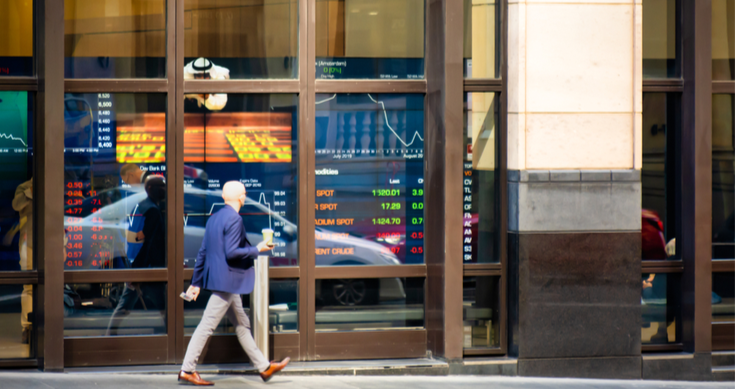- Index ETF vs Fully Invested Manager vs Cash-Flexible LIC – the difference comes down to their investment rules
- LIC’s top stock picks and strategic investments – have a set of rules that allows them to stray from the market’s heavy-weights
- Why we pay Active Managers to hold 30%+ cash – it is a strategic and defensive play for them
- The common theme for most LIC’s was to steer clear of mining stocks – however some are seeing new opportunities in this sector
The Australian share market has fallen over the last six months, and been choppy, or volatile along the way. While cash in the bank has beaten the share market (and index based ETFs), Active Managers (LICs) have made record profits with a strong 2015, but how much of that performance was because they held cash?
Index ETFs tied to a Sinking Ship
Plain-vanilla ETFs have been tied to the sinking ship of the ASX for the last few months. Australia’s most popular ETF that holds Australia’s Top 200 in an ETF (SPDR S&P ASX Top 200; STW) is down -10.6% over the last year, or 7.5% over the last six months.
The key differences and drivers behind an Active Manager’s strong performance against a lackluster index (and Index ETF) returns is the difference in their investing rules:
- Index / ETFs / Passive Managers have a set of hard and fast investment rules to follow and remain fully invested in ‘rain, hail or shine’;
- Stock Picking: Active Managers / LICs have a self-prescribed set of rules to focus their investment decisions which enables their portfolio to stray from the market’s heavy-weights;
- Open Mandate: Active Managers can choose to hold cash (some up to 80%), while ETFs do not have this flexibility
Fully Invested Active Managers
Some Active Mangers choose to be fully invested. These managers provide a stronger ground for comparison to the ETFs because both have been (almost) fully invested for the comparison period.
| Type | Code | CY15 Beat Index by | Current Cash holding % of Fund |
| Fully Invested Active Managers | AUP | 6% | 0% |
| NCC | 6% | 1% | |
| MIR | 10% | 3% | |
| ETFs | STW | 0% | 0% |
The stronger performance of these Active Mangers is attributed to Stock Picking, rather than holding cash. Here are the current strategic investments and recent top picks that have provided strong returns for these ‘Fully Invested’ Active Managers:
- Aurora Property Buy-Write (AUP) actively avoided property developers such as Cromwell (CMW) Charter Hall (CHC) that spent most of 2015 falling. But focused on stable REITs with tenants exposed to food and liquid that have held up around their highs such as BWP and SCP. All of this while being fully-invested (no cash holdings) in a falling market.
- Naos Emerging (NCC) holds a focused portfolio of approximately 10 shares and focused their investments on smaller companies with overseas earnings and a strong ability to scale into these growth opportunities.
- Mirrabooka (MIR) received strong gains from Treasury wines (TWE), Vocus (VOC) and aligned their portfolio to aged-living and healthcare with a focus on company management being substantial shareholders in their own companies.
Cash is King for Active Manager’s returns
Stock-picking has always been the polarising factor between Active Managers, but how much cash they hold (often referred to as a part of an ‘open mandate’) has become a more significant factor in this market environment.
Roger Montgomery from the Montgomery fund has been an advocate of high cash reserves since early 2014. In 2015, Montgomery’s high cash reserves gave their fund a 16% better return than the Australian Market as a whole, and they’re not alone. The size of the cash hoards sitting behind some of these Active Managers is surprising, see the table below:
| Code | CY15 Beat Index by | Current Cash holding % of Fund |
| KAT | 9% | 41% |
| CDM | 11% | 34% |
| Montgomery Retail | 16% | 24% |
| WAM | 22% | 32% |
| GC1 | 29% | 39% |
As the table shows, some of these market-leading Active Managers are holding a lot of cash.
LIC’s Stock Picking and Strategic investments:
Cash played a role in these fund’s figures above, however the stock picking remains the key driver of performance in recent times.
The common theme across the LICs was avoiding mining (however some managers have just recently changed their stance on that). Here are the current strategic investments and recent top picks that have provided strong returns for the LICs:
- Katana Capital (KAT) who backed a winning recent float BWX (BWX) and picked the February-March 2016 gold rally with Troy Resources (TRY) and Sandfire Resources (SFR). Has also been keeping their powder dry with high cash reserves;
- Cadence (CDM) invested in Melbourne IT (MLB) and shorted (made money when falling) RIO and Woodside (WPL) along with selective international investments adding to their LIC’s performance
- WAM hold the view that the global macro-economic picture is still tough, so focused on a bottom-up approach (companies). TWE has been a strong performer for WAM, along with Pacific Brands (PBG) and RCG targeted because these two companies are in a strong position to grow sales, stores and margins. WAM are still actively avoiding mining and mining-derivative industries.
- Glennon Small Companies (GC1) took BWX at the float (IPO), also held Mayne Pharma (MYX) and APN Outdoor (APO) throughout 2015 to provide strong returns. GC1’s returns were helped by the recent capital raising in August last year which was kept their cash balance high throughout the recent market drop.
Should an Active Manager hold so much cash?
Many investors complain that these Active Managers’ cash holdings are too high and this is not why they engaged a ‘Professional Manager’. But high cash holdings can be a defensive decision in falling markets.
How much cash an Active Manager holds, if at all comes down to each investor’s portfolio and their allocation to cash. This is a very important question for SMSFs trustees who must address this as a part of their obligations to their SMSFs. If the portfolio must be invested in shares and not cash, then the LICs with open mandates (ability to hold cash) might not appeal to such investors.
Whatever one’s opinion on the matter is, these high cash-holdings have made it easier for Active Managers to beat a falling market over the last year, especially those holding a lot of cash. It’s clear to see in the tables above that holding cash is also an active decision in this market.
When you speak with most of these Active Managers, they’re not looking to deploy all that cash in a hurry. That’s no surprise considering the 2016 forecasts from most Australian brokers are for muted out-looks on the ASX and Australian economy as a whole.
Eventually the market tide will turn. While no one knows exactly when the market will turn, these Active Managers remain agile and ready to re-align their portfolios or invest the cash reserves according to the market conditions and that is why we engage Active Managers in this market environment.









